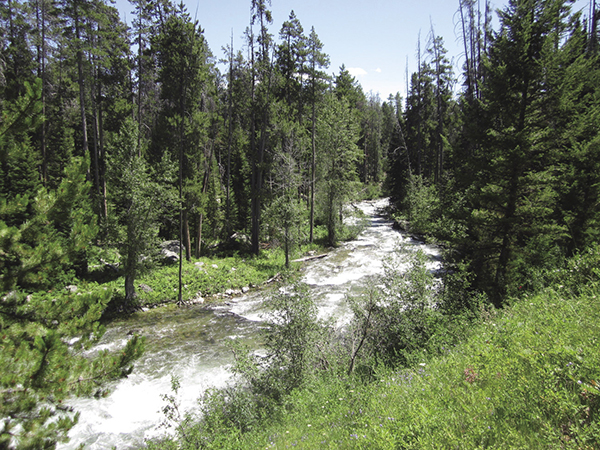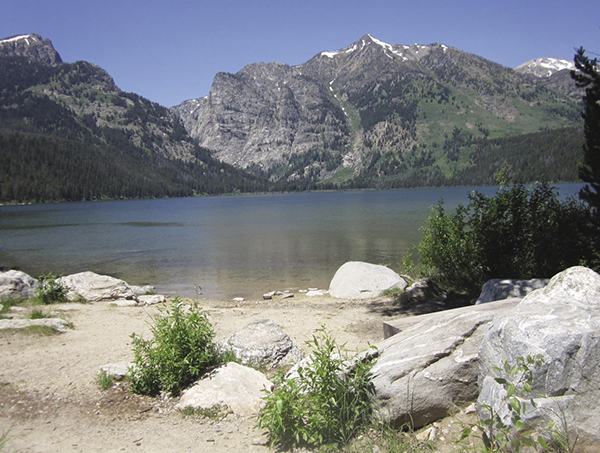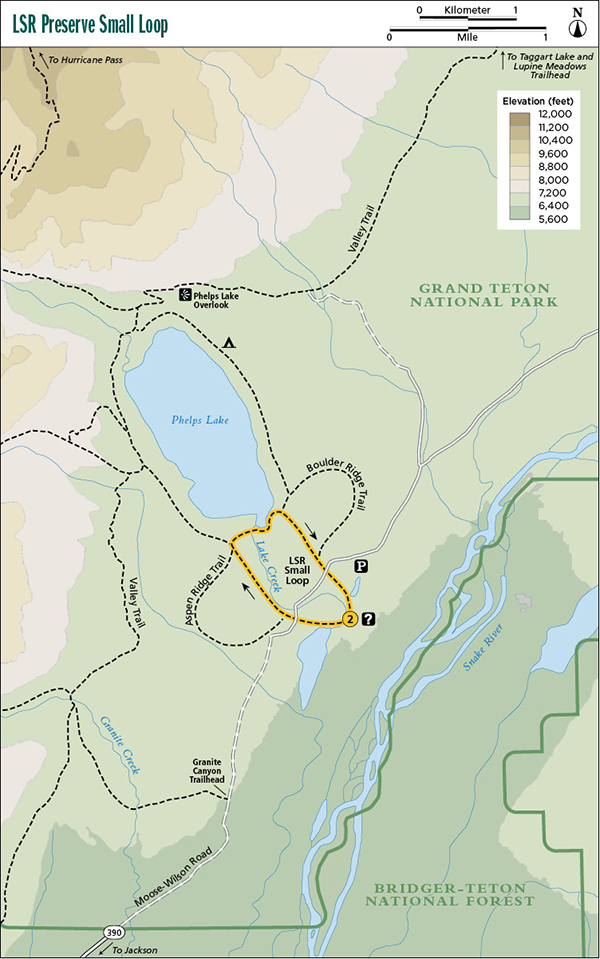
The main LSR trail follows Lake Creek.
2 LSR Preserve Small Loop
Description: An easy and popular day hike to a low-elevation lake
Start: Laurance S. Rockefeller Preserve Interpretive Center
Total distance: 3.0-mile loop
Best season: June through Sept
Maps: Earthwalk Press Grand Teton map; LSR Trail Guide, available free at the trailhead
Finding the trailhead: Drive north of Teton Village on Moose-Wilson Road for 4.4 miles, turn right (east) into the Laurance S. Rockefeller Preserve, and drive 0.5 mile more to the parking area. Since parking space is limited by design to minimize the environmental impact, park close to other vehicles to free up as many spaces as possible. The parking area has a high-tech composting toilet with running water. The parking lot usually fills up by 11 a.m. No overnight parking is allowed. Trailhead GPS: 43.626403 / -110.775381
The Hike
The Laurance S. Rockefeller Preserve (LSR Preserve) has a small but expertly designed system of trails that connect with long-established trails outside the preserve in the park, providing hikers with several options for loop hikes. I’ve included two—one short and one long—in this book, but you can easily modify these routes to fit with your ambitions for the day.

The main LSR trail follows Lake Creek.
The LSR Preserve officially opened to the public in June 2008, and it’s all about returning what had previously been private land to the American people and restoring wild nature to the greatest extent possible while allowing all of us the opportunity to experience it. From 2004 to 2007, thirty buildings plus multiple roads and utilities were removed from the 1,106-acre preserve and the sites reclaimed. In the parking lot, two of the best spaces are reserved for hybrid vehicles. You won’t find paper towels or lights in the bathroom, and there are no trash cans in the parking lot. This is, according to the NPS, a Leave No Trace facility, so you must pack out what you pack in, and that includes in the parking lot. Even the trail signs are knee high to make them minimally obtrusive. Unlike many other park trails, horses are prohibited on LSR Preserve trails.
This 3-mile loop up one side and down the other side of Lake Creek, the outlet of Phelps Lake, is the primary hike in the LSR Preserve and the one most often used for ranger-guided hikes. If you’re interested in a guided trip, call the interpretive center in advance (307-739-3654) to check on the schedule and availability.
This entire route is well defined and heavily used, so expect to see a lot of people out enjoying the preserve. All stream crossings have sturdy bridges, and there’s even a modern composting toilet at Phelps Lake.
You can take the loop clockwise or counterclockwise with no change in difficulty, but this description follows the clockwise option.

The view from the rest area on the shore of Phelps Lake.

This sign in the LSR Preserve parking lot gives you a clue of the guiding philosophy of this “new wilderness.”
After taking the short walk from the parking lot to the interpretive center, you’ll find the trailhead on the west side of the spiffy, “bright green” building. I call it that because the interpretive center is the first platinum-level Leadership in Energy and Environmental Design (LEED)–certified building ever constructed in the National Park System.
After 0.1-mile, you can stop at two platforms, one constructed over Lake Creek and another at the base of a small waterfall on a Lake Creek tributary coming in from the north. Shortly after these viewpoints, the trail forks. Go left (southwest) on the Lake Creek Trail, which closely follows the cascading mountain stream most of the way to Phelps Lake. At the junction with the Aspen Ridge Trail and the connecting trail to the Woodland Trail, go straight.
At the lake, you’ll find an idyllic viewpoint with benches, perfect for relaxing and soaking in the view of Albright Peak and Rendezvous Mountain as they reflect in Phelps Lake, definitely one of the most spectacular vistas in Grand Teton National Park.
From here, the trail follows the lakeshore for about a half mile, crossing Lake Creek on the nicest bridge I’ve ever seen, complete with benches beckoning you to stop and enjoy it instead of simply crossing and leaving it behind. Also, you can take one of several short spur trails down to the lakeshore and find a private spot to savor the scenic splendor and allow the wild essence of the place to take root in your consciousness.
When you reach the junction with the Woodland Trail, turn right (southeast). From here, the trail drops gradually all the way back to the interpretive center. If you didn’t stop to see the fantastic interpretive displays before you started the hike, be sure to take time to check them out before heading back to the parking lot. The NPS staffs the interpretive center with rangers eager to answer any questions you might have.
Before you drive away, take a moment to think how fortunate we are that Laurance S. Rockefeller decided to donate this amazing place to the park for the enjoyment of future generations instead of selling it for many millions to a developer. Let’s hope this idea catches on among the super rich.
Options: You have several options for lengthening your trip. You can add the 4-mile loop around Phelps Lake (total distance, 9 miles). You can also add the Aspen Ridge Loop (total distance, 4.6 miles) or the Boulder Ridge Loop (total distance, 3.9 miles)—or both, of course.

Miles and Directions
0.0Laurance S. Rockefeller Interpretive Center
0.1Trail splits; turn left onto Lake Creek Trail
0.6Cross Moose-Wilson Road
0.7Junction with Aspen Ridge Trail and connecting trail to Woodland Trail; go straight
1.5Phelps Lake and junction with Aspen Ridge Trail; turn right
1.7Toilet
1.8Lake Creek
1.9Junction with Phelps Lake Trail; turn right onto Woodland Trail
2.3Junction with Boulder Ridge Trail and connecting trail to Lake Creek Trail; go straight
2.6Moose-Wilson Road
2.9Junction with Lake Creek Trail; turn left
3.0Laurance S. Rockefeller Interpretive Center